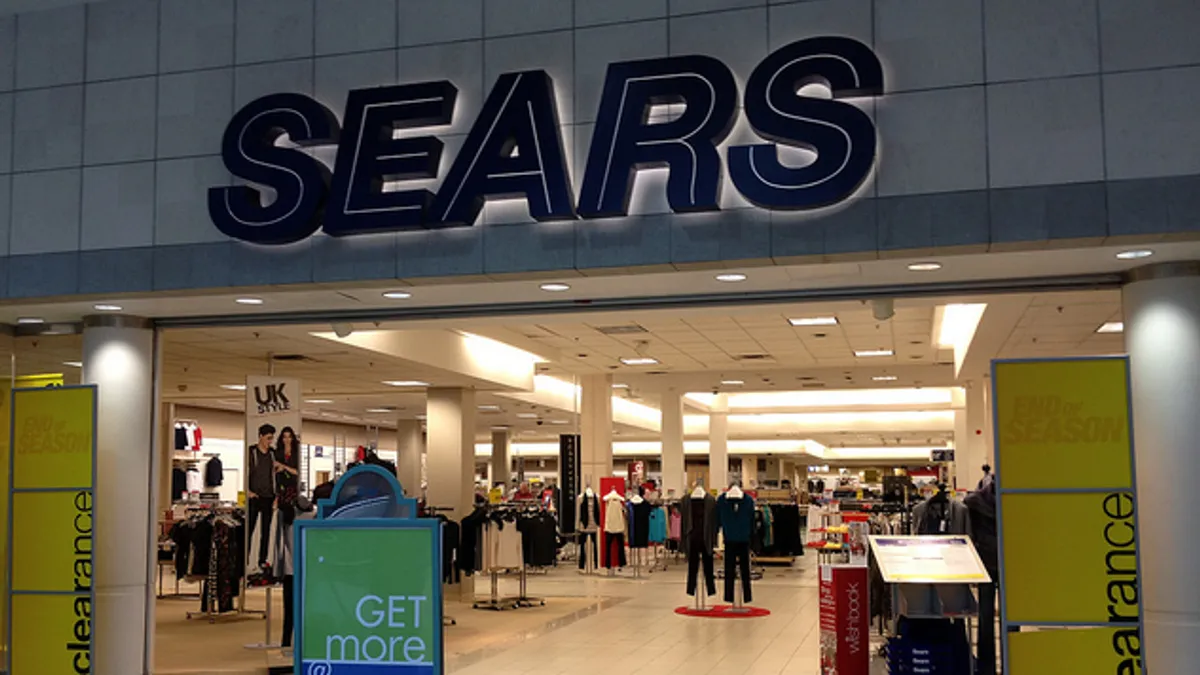Dive Brief:
- Sears Holdings announced a new round of corporate layoffs on Tuesday. The struggling retailer said in a press release it will slash 400 full-time jobs at its corporate offices and throughout its global support operations. These come on top of store positions eliminated this year as the company moves to shutter around 250 stores.
- The company said Tuesday that the restructuring moves made so far this year has reduced costs by an annualized $1 billion and Sears is on pace to save $1.25 billion in annualized costs for fiscal 2017.
- Along with reducing costs, Sears said it has paid down $418 million on outstanding term loans, made $200 million from real estate sales and other monetization efforts, and has grown its Shop Your Way loyalty program. The company did not provide specific figures with the statement, but a spokesperson noted to Retail Dive that the Shop Your Way VIP program has grown 50% year-to-date.
Dive Insight:
Sears’ latest round of corporate layoffs comes on top of the 130 job cuts announced in February and hundreds of eliminated positions in 2016 and 2015, not to mention the hundreds of store employees that will lose their jobs as nearly 250 stores close this near. It represents yet another move by CEO Eddie Lampert and his team to keep the company solvent amid years of losses and a retrenching department store sector.
Sears on Tuesday projected an upbeat and focused face when turning toward the future. In its release, the company said it would “focus our investments to drive the growth of our valuable assets,” including its loyalty program, appliance and tool brands, as well as the auto, home and product repair services. “We remain focused on realigning our business model in an evolving and highly competitive retail environment,” Lampert said in a statement. “This requires us to optimize our store footprint and operate as a leaner and simpler organization."
But many analysts and observers say the company is careening toward irrelevance and even insolvency as it sheds valuable assets, stores and employees. In March, Sears expressed diminished hopes in its ability to continue operating, according to its annual report filing with the Securities and Exchange Commission.
In April, Moody’s analysts noted the company’s many restructuring efforts, including corporate cuts and property sales, and questioned whether “the company’s operations strategies will be sufficient to reduce its cash burn to break-even levels.” David Silverman, senior director of Fitch Ratings’ retail coverage, said in an interview Monday that there is still significant risk that Sears could go bankrupt in the next 12 to 24 months. He noted that Sears needs about $2 billion a year in liquidity to fund its earnings losses, pensions and other fixed obligations. “While recent moves should help Sears function in 2017, they have not truly changed company’s long-term future,” Silverman said, prior to Sears latest announcement of corporate cuts.
While cost cuts have helped shore up Sears’ balance sheet and stave off insolvency, some think the company is hurting its long term prospects by the very same moves. Rather than devising a plan to rebuild store traffic and drive growth (its much-touted and somewhat successful Shop Your Way omnichannel effort notwithstanding), Sears continues to rely on financial engineering that merely props it up, Greg Portell, lead partner in Retail Practice at consulting firm A.T. Kearney, told Retail Dive earlier this year.
“Successful transformations make some big cuts and some big moves, and growth reemerges. Here after three or four of those little cuts where they haven’t been able to get growth going, we start to lose faith,” Portell said. “There is certainly a place for financial reengineering. But when Sears goes back to it numerous times, it is an indicator they don’t have a real business solution.”
The sale of Sears’ Craftsman brand to Black and Decker falls into the same pattern. Walter Loeb, retail veteran and president of consulting firm Loeb Associates, described the sale as a “desperate move” in a discussion forum on RetailWire earlier this year. “Selling iconic brands is devastating to the store. We are going to see a shrinking company with further losses.”














